| (insert your NIE or newspaper logo here) |
Weekly Online LessonOnline Lesson ArchiveGrade Level: 7-11
|
Suffering in Sudan
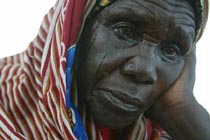 Over the last month or so, the global community has been hearing more and more about the escalating civil war in Sudan -- more specifically, in the nation's region referred to as Darfur (alternatively spelled, Darfor).
Over the last month or so, the global community has been hearing more and more about the escalating civil war in Sudan -- more specifically, in the nation's region referred to as Darfur (alternatively spelled, Darfor).
At least 30,000 Sudanese, mostly black Africans, have been killed. Thousands more have been displaced from their homes, many fleeing across the western border into Chad, where aid has been hampered by torrential rains and sandstorms.
The United Nations has called it, "The world's worst humanitarian crisis."
Essentially, the conflict lies between Sudan's two major ethnic groups -- the Arabs and the black Africans, which include hundreds of ethnic divisions and language groups. There are as many as 90 African and Arab tribes and clans in Darfur alone.
For centuries, primarily black African farmers have been living in the area's lush highlands. The Fur, or "For," tribe dominated the region, giving it the name Darfur, meaning "Homeland of the Fur." More recently, nomadic Arab herders have been encroaching on these lands.
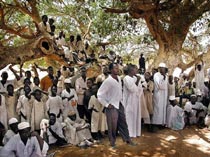 Tension turned to violence in February 2003, when rebels got tired of the government unjustly favoring Arabs over Africans. In response, Arab gunmen on horses and camels, backed by bombers and helicopter gunships, have razed hundreds of black African villages.
Tension turned to violence in February 2003, when rebels got tired of the government unjustly favoring Arabs over Africans. In response, Arab gunmen on horses and camels, backed by bombers and helicopter gunships, have razed hundreds of black African villages.
Many believe that Sudan’s Arab Islamist government in Khartoum began to manipulate the region’s ethnicity in the 1980s, pushing Arab tribes westward. Some have also accused the government of purposefully keeping the Darfur region undeveloped, impoverished, and generally ignored.
Many hoped that the recent peace talks, mediated by the African Union in neighboring Ethiopia, would bring some relief.
But on Saturday, July 17, 2004, that hope disintegrated when the representatives of the two main Black African rebel groups -- the Justice and Equality Movement and the Sudanese Liberation Army -- walked out, saying that some preconditions must first be met by the Sudanese government. These included, disarming the Arab militias and fulfilling previous negotiated agreements.
As mediators continue trying to bring together all sides for a peaceful resolution, it's important to understand more about the history and complexity of this region. So in this week's lesson, you'll focus on causes of recent events then look into the deeper history of northern Sudan, when it was dominated by the Nubians.
The Darfur Crisis
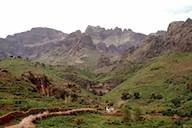 To get a good grasp of what's happening in Sudan's Darfur region, let's join the OnlineNewsHour at PBS for their special feature, published mostly in late June, on the Crisis in Sudan.
To get a good grasp of what's happening in Sudan's Darfur region, let's join the OnlineNewsHour at PBS for their special feature, published mostly in late June, on the Crisis in Sudan.
First, get oriented by reviewing the Map of Sudan. You'll see that the Nile River, including its upper tributaries -- the Blue Nile and White Nile, flow through the eastern half of the country. The Darfur region lies west, outside of the Nile River Basin. Where do the refugee camps lie?
Return to the home page, and uncover The Origins of the Darfur Crisis.
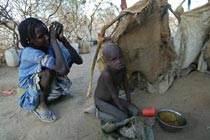 What is the name of the Arab militia being blamed for the genocide-like killings? What exactly did the rebel groups want from the government? What are the possible fates refugees face and why?
What is the name of the Arab militia being blamed for the genocide-like killings? What exactly did the rebel groups want from the government? What are the possible fates refugees face and why?
Can you identify one or more reasons that the United States would not want to characterize the civil war as "ethnic cleansing" or "genocide"?
Now meet some of Darfur's Refugees by watching the streaming video, listening to the RealAudio segment, or reading the transcript on the page. What are some of the challenges the refugees face once they've left Sudan? How does their presence affect host countries, like Chad?
The Nubians
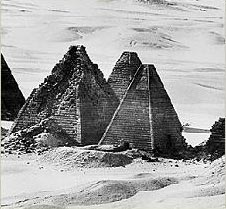 Let's turn our focus to the eastern side of Sudan, particularly the northern region where the mighty Nile River forms and where Ancient Nubia: Egypt's Rival in Africa thrived centuries ago. Click Visit Site to enter.
Let's turn our focus to the eastern side of Sudan, particularly the northern region where the mighty Nile River forms and where Ancient Nubia: Egypt's Rival in Africa thrived centuries ago. Click Visit Site to enter.
Begin with the Introduction, and read about Ancient Nubia. Also review the area's Geography and Topography -- download and print out the second (color) map, if possible. It illustrates the locations of the five cataracts and will help keep you oriented through the site's narrative.
Where does present-day Sudan lie on the map? In which direction does the Nile River flow? What are some topographical features between the upper and lower regions of the Nile? What exactly is a cataract? How do you think the topography of this river basin and its location influenced how it was settled and developed by human cultures?
What kind of Climate and Natural Resources have prevailed in this region? What major event inspired the First Survey to dig up the Archaeological History of Nubia?
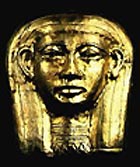 Now walk through the hallways illustrating Bronze Age Nubia. Read the Introduction, then learn about the three cultures that define the different periods of Nubian history: the A-group, the C-group, and the Kerma.
Now walk through the hallways illustrating Bronze Age Nubia. Read the Introduction, then learn about the three cultures that define the different periods of Nubian history: the A-group, the C-group, and the Kerma.
What have excavations of graves and other important sites revealed about each of these cultures? What have experts concluded about their relationships with Egypt and the rest of the world? What happened during The Colonial Period?
Explore further the Kingdom of Kush. After reviewing the Introduction, discover what happened during the Napatan Period and the Meroitic Period.
Where exactly were these capital cities located in relation to the Nile River and each other? What were some of the differences and similarities in the burial ceremonies and religion of the two periods? Who were some of the important figures of these eras? How did the relationships between Nubia and Egypt change over time and why? What else has archaeology helped us learn about Nubia?
Lastly, find out who the X-group was. What were some of the differences and similarities between this group and the others? What happened during the Christian Period?
In what ways do you think the region's Nubian past, and its deep connections to Egypt, has influenced today's Sudan?
If you have time, take the Online Quiz, covering both the Bronze Age Nubia and Kush sections.
Newspaper Activities
In a current issue of The Salt Lake Tribune, look for stories about Sudan or related topics. Have food and supplies reached the refugee camps yet? Who is providing aid to them? How is Chad coping with these conditions? Have peace talks resumed? If not, why not? What is the Sudanese government's position? Is anything being done on the ground in Darfur to stop the Arab militias? In what way is the United States getting involved?
© Copyright 2004
Learners
Online,
Inc.
